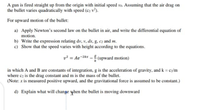Question

Transcribed Image Text:A gun is fired straight up from the origin with initial speed vo. Assuming that the air drag on
the bullet varies quadratically with speed (c2 v²).
For upward motion of the bullet:
a) Apply Newton's second law on the bullet in air, and write the differential equation of
motion.
b) Write the expression relating dv, v, dx, g, cz and m.
c) Show that the speed varies with height according to the equations.
v? = Ae-2kx - (upward motion)
in which A and B are constants of integration, g is the acceleration of gravity, and k = cy/m
where cz is the drag constant and m is the mass of the bullet.
(Note: x is measured positive upward, and the gravitational force is assumed to be constant.)
d) Explain what will change yhen the bullet is moving downward
Expert Solution
Want to see the full answer?
Check out a sample Q&A hereKnowledge Booster
Similar questions
- Consider a skier heading down a 11° slope. Assume the coefficient of friction for waxed wood on wet snow is μk = 0.10 and use a coordinate system in which down the slope is positive. a. Calcuate the magnitude of the acceleration of the skier in m/s2 b. Find the angle, in degrees, of the slope on which this skier could move down the slope at constant velocityarrow_forwardd. Force is a vector quantity and thus has both a magnitude and a direction. A vector can be represented graphically by a line drawn to scale in the direction of the line of action of the force. To distinguish between vector and scalar quantities, various ways are used. Identify and explain threeof these ways.arrow_forwardA 15.0 kg load of bricks hangs from one end of a rope that passes over a small, frictionless pulley. A 28.0 kg counter weight is attached to the other end of the rope, as shown in the figure. You may model the rope as a massless string. The system is released from rest. A. Draw two freebody diagrams, one for the load of bricks and one for the counter weight. B. Find the magnitude of the upward acceleration of the load of bricks. 28.0 kg C. What is the tension in the rope? D. How does the tension compare to the weight of the bricks and the weight of the counter weight? 15.0 kgarrow_forward
- An object of mass m is at rest on a smooth horizontal surface. It is pulled by a variable force F = kt, where t is the time. The force makes and angle a with the horizontal. a) find an expression for the speed of the object when it starts to lift-off the surface. b) find an expression for the distance travelled until it starts to lift-off the surface.arrow_forwardConsider an object on an incline where friction is present. The angle between the incline and the horizontal is θ and the coefficient of kinetic friction is μk. a.) Find an algebraic expression for the acceleration of this object. Treat down the incline as the positive direction. b.) Calculate the acceleration, in meters per second squared, of this object if θ = 31° and μk = 0.34. Treat down the incline as the positive direction.arrow_forwardA 5.0 kg object has a set of three forces acting on it, as shown in the diagram. At t = 0, the object is located at the origin and is at rest. a) Use Newton’s second law to find the acceleration of the object. Give both the magnitude and the direction (relative to the +x axis). b) What is the velocity of the object at t = 7.50 seconds? Give both the magnitude and the direction (relative to the +x axis). c) How far is the object from the origin at t = 7.50 seconds?arrow_forward
- Newton's first law states that: Group of answer choices Ia. n the absence of any net force acting on it, a mechanical system is necessarily at rest. b. In the absence of a non-zero net force acting on it, a mechanical system keeps moving in the same direction at the same speed (including the case v=0). c. For any pair A/B of objects interacting with one another, the force of A acting on B is the equal-opposite of the force of B acting on A. d. The rate of change of the velocity of a system is proportional to the net force acting on it.arrow_forwardA skater of mass m standing on ice throws a stone of mass M with speed v in a horizontal direction. Find the distance over which the skater will move in the opposite direction if the coefficient of kinetic friction between the skater and the ice is ?k . (Use any variable or symbol stated above along with the following as necessary: g.)Δx =arrow_forwardTopic: You find yourself trapped in the middle of a large frozen lake. Assume the ice has no friction. All you have on your is warm winter clothing and no way to call/signal for help. You can just barely see the shore in the distance. Use your physics knowledge of Newton's laws to help get you off the lake. Explain your reasoning.arrow_forward
arrow_back_ios
arrow_forward_ios